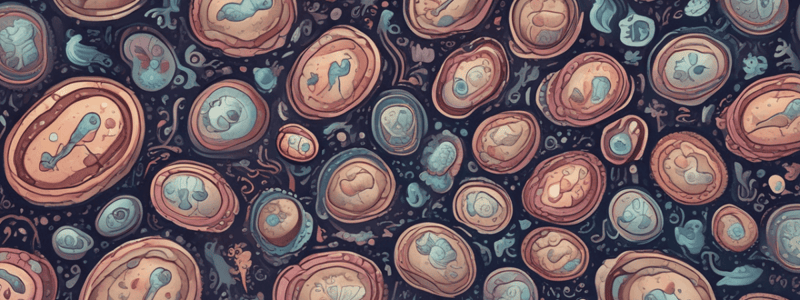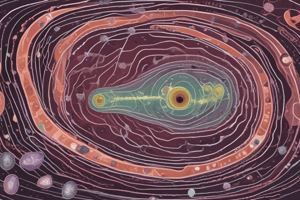Podcast
Questions and Answers
What is the characteristic feature of apicomplexa parasites?
What is the characteristic feature of apicomplexa parasites?
- They are obligate intracellular parasites (correct)
- They are obligate extracellular parasites
- They are found only in cats
- They have a simple life cycle
What is the role of the apical complex in Toxoplasma gondii?
What is the role of the apical complex in Toxoplasma gondii?
- It helps in digestion of host cell membrane
- It helps in penetration of host cells (correct)
- It helps in evasion of host immune system
- It helps in reproduction of the parasite
Where does the parasite multiply sexually in the cat's body?
Where does the parasite multiply sexually in the cat's body?
- In the RES cells of the brain and eye
- In the spleen and liver
- Inside the intestinal epithelial lining by Gametogony (correct)
- In the epithelial lining of the intestine
What is the definitive host of Toxoplasma gondii?
What is the definitive host of Toxoplasma gondii?
What is the asexual form of Toxoplasma gondii?
What is the asexual form of Toxoplasma gondii?
Which stage of Toxoplasma gondii is infective during transplacental infection?
Which stage of Toxoplasma gondii is infective during transplacental infection?
What is the shape of the tachyzoite?
What is the shape of the tachyzoite?
What is the mode of infection by ingesting contaminated cat feces?
What is the mode of infection by ingesting contaminated cat feces?
Which of the following individuals are at high risk of life-threatening toxoplasmosis?
Which of the following individuals are at high risk of life-threatening toxoplasmosis?
In which cells of the human body does the parasite multiply asexually?
In which cells of the human body does the parasite multiply asexually?
What is the infective stage in organ transplantation?
What is the infective stage in organ transplantation?
How many major genotypes of Toxoplasma gondii are known?
How many major genotypes of Toxoplasma gondii are known?
What is the fate of tachyzoites in the human body?
What is the fate of tachyzoites in the human body?
What is the percentage of the population infected with Toxoplasma gondii?
What is the percentage of the population infected with Toxoplasma gondii?
What is the definitive host in the sexual cycle of Toxoplasma gondii?
What is the definitive host in the sexual cycle of Toxoplasma gondii?
What is the primary site of infection in Toxoplasma gondii infection?
What is the primary site of infection in Toxoplasma gondii infection?
What is the infective stage of Toxoplasma gondii that attacks epithelial cells?
What is the infective stage of Toxoplasma gondii that attacks epithelial cells?
Which type of blood transfusion is safe from Toxoplasma gondii infection?
Which type of blood transfusion is safe from Toxoplasma gondii infection?
What is the type of infection that occurs when Toxoplasma gondii is transmitted from mother to fetus?
What is the type of infection that occurs when Toxoplasma gondii is transmitted from mother to fetus?
What is the characteristic of Toxoplasma gondii infection in immunocompromised patients?
What is the characteristic of Toxoplasma gondii infection in immunocompromised patients?
What is the mode of transmission in research workers and butchers?
What is the mode of transmission in research workers and butchers?
What is the common symptom of acquired toxoplasmosis?
What is the common symptom of acquired toxoplasmosis?
Flashcards are hidden until you start studying
Study Notes
Toxoplasma Gondii
- Intermediate hosts: humans and other mammals (e.g., sheep, cattle, pigs, birds, and mice)
- Infective stage: all forms of T. gondii are infective to humans
Life Cycle
- In cat:
- Intestinal stage: asexual multiplication by Schizogony, then sexual multiplication by Gametogony
- Extra-intestinal stage: asexual multiplication in other body organs
- In humans and other mammals:
- Asexual multiplication in RES cells of spleen, liver, lymph nodes, muscles, heart, bone marrow, brain, eye, and kidney
Mode of Infection
- Eating raw or undercooked beef, pork, or mutton containing T. gondii cysts
- Ingestion of oocysts in material contaminated with infected cat feces
- Transplacental transmission during active infection
- Blood, white cells, or platelet transfusion
- Organ transplantation
Phylum Apicomplexa (Sporozoa)
- General features:
- Obligate intracellular parasites
- Have an apical complex to attach to and penetrate host cells
- Complex life cycle with alternating sexual and asexual generations
- Members of this phylum include:
- Toxoplasma gondii
- Plasmodium spp.
- Babesia spp.
- Cryptosporidium parvum
- Isospora belli
Toxoplasmosis
- Geographical distribution: worldwide (except Antarctica)
- Toxoplasma gondii attacks humans and animals (cats)
- Three major genotypes (type I, type II, and type III) differ in pathogenicity and prevalence
- Infects a large number of the population (perhaps 1/3), but uncommonly causes clinically significant disease
- High-risk groups: immunologically impaired patients, fetuses, and newborns
Morphology of Toxoplasma Gondii
- Asexual forms:
- Tachyzoite (trophozoite): the actively multiplying, asexual form in humans
- Pyriform in shape with an apical complex at the pointed end
Life Cycle of Toxoplasma Gondii
- Development in cat intestines:
- Sporulated oocyst
- Sporozoites and bradyzoites attack epithelial cells
- Development in human intestine:
- Unsporulated oocyst passes in stool of the cat
- Sporulated oocyst infects humans
Pathogenesis and Clinical Picture of Toxoplasmosis
- Toxoplasmosis is considered an opportunistic infection
- Acquired infection: acquired toxoplasmosis
- Congenital infection: congenital toxoplasmosis
- Recrudescence in immunocompromised patients
Symptoms of Acquired Toxoplasmosis
- Depends on immune status and age of infected person, virulence of infecting strain
- Most cases are asymptomatic
- Mild form: lymphadenopathy, myalgia, low irregular fever, slight anemia with lymphocytosis, fatigue
Studying That Suits You
Use AI to generate personalized quizzes and flashcards to suit your learning preferences.



